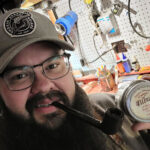By G. L. Pease
 Welcome to the sixth edition of Ask G.L. Pease. It’s always a lot of fun going through the mailbag to select questions for the column, and this month was no exception. The questions are sometimes so specific that I simply email the querent with the answer. Or, they’ll be too straight forward, or not of general interest, an in that case, a quick reply with a link to a page with the answer is the best response. Once in a while, there’s the question I’ve answered so many times in different venues, my eyes begin to bleed when I read it again. Others are so complex that I wonder if some people are sending me up, or just have too much time on their hands. (How should I know which zoo? I’m not doctor bloody Bronowski!*)
Welcome to the sixth edition of Ask G.L. Pease. It’s always a lot of fun going through the mailbag to select questions for the column, and this month was no exception. The questions are sometimes so specific that I simply email the querent with the answer. Or, they’ll be too straight forward, or not of general interest, an in that case, a quick reply with a link to a page with the answer is the best response. Once in a while, there’s the question I’ve answered so many times in different venues, my eyes begin to bleed when I read it again. Others are so complex that I wonder if some people are sending me up, or just have too much time on their hands. (How should I know which zoo? I’m not doctor bloody Bronowski!*)
This month, there was a question that intrigued me so much that I dove down a very deep rabbit hole for hours doing research. I didn’t come back completely dry, but some critical parts are still missing, so I’ll have to defer it until a later edition. (That’s called a teaser, I think. It’s supposed to get he reader to come back. I sure hope it works.)
So, this month, we’ve got a few that I found interesting. I hope you do, too.
 Here are a couple of related questions about terminology. We often hear or use words to describe tobaccos that may not convey very precise meaning to the newcomer, and, worse, different people have different interpretations of what the terms mean. What a mess! The whole Balkan/English issue is difficult enough, but what about Scottish and Irish blends?
Here are a couple of related questions about terminology. We often hear or use words to describe tobaccos that may not convey very precise meaning to the newcomer, and, worse, different people have different interpretations of what the terms mean. What a mess! The whole Balkan/English issue is difficult enough, but what about Scottish and Irish blends?
Chris from Germany asks: I try to find out the specific differences between English, Scottish and Irish types of pipe tobacco. And I’m stuck at the point, that maybe Scottish and Irish blends seem to be more Virginia based rather than the English. But – what makes the difference between Scottish and Irish…? Is it the ‘aroma’ style of the casing? Hope, you can help me out.
Chris, I wish I had a definitive answer to this one. The Scottish term has always been something of a mystery, at least to me. Most seem to apply it to a predominately virginia blend with some latakia and orientals to fill it out, but others might think of straight matured virginias. The most famous Scottish blending house was arguably Charles Rattray’s, and we could perhaps turn our attention there for more understanding, but not even that helps. His product range presented some signature characteristics by virtue of his special treatment of the virginias he used, but some of his most famous products were mixtures comprising Latakia and oriental tobaccos as well. What pops into my head when I hear the term Scottish mixture is one that is dominated by matured virginias, with or without some oriental component used sparingly as spice to the mix, but it’s hard to say if there’s really a difference between that and what some would term a "light English."
Irish tobaccos, to my mind, tend to be very potent, strong blends, made either exclusively from virginias, dark air- and fire-cured tobaccos, or are at least dominated by them, and which are often, as you mention, topped or scented, and frequently presented as cut plugs (flakes). Erinmore is possibly the most famous of these, a tobacco well known for both its power and perfume, and a few of Peterson’s offerings fill that bill as well. But, the fact that other companies use the term clouds the waters a bit. For instance, the renown English firm of Gawith Hoggarth, produces black and brown Irish Twists. These tobaccos satisfy the dark, strong characteristics, so maybe that’s the defining idea. Really, it’s another one of those terms that seems to have a somewhat different connotation, depending on who you ask, which isn’t very helpful.
 And, then Tony wants to know: Gregg (sic) will you tell us the difference, if any, between English Blends and Balkan Blends?
And, then Tony wants to know: Gregg (sic) will you tell us the difference, if any, between English Blends and Balkan Blends?
A: I didn’t know how best to approach the answer to this one, either, so I typed "English Balkan Blends" into a Google search, and the first thing to come up was this: What is a Balkan Blend. I clicked on the link, and had a great read. This guy really seems to know almost as much as doctor Bronowski, and the article is not only informative, but also quite entertaining. Check it out! He did a far better job than I can discussing the terminology. I’m pretty sure his column appears monthly, and it’s probably worth reading regularly.
This one is from Mike: Although I’ve always enjoyed a variety of your blends (and still do) more recently I’ve got my hands and have been enjoying Esoterica’s "Stonehaven". This is a marvelous all around tobacco as far as flavor, burn aroma, moisture level etc.
Do you know all the tobacco (or other) ingredients in this superb blend? And, do you formulate anything similar?
A: Mike, I’ve got some ideas about what the blend’s makeup is, and some thoughts about the processing, but it wouldn’t be right for me to speculate about another company’s products. But, I fully agree with you that Stonehaven is a remarkable tobacco. Currently, I don’t produce anything similar, but, I’m working on something that, whilst quite different, may satisfy in a similar way. I’ve been round quite a few bends with this one, and am still not approaching the home stretch. I know what I’m chasing, but getting there is sometimes the hard part.
And, since we’re talking about tobaccos that are like other tobaccos, Val writes: Are there any worthy replacements to Bohemian scandal in the range of your wonderful blends?
A: My wonderful blends. I really like that. Thanks, Val! Your cheque’s in the post. What made Bohemian Scandal special was the exquisite vintage Syrian Latakia that comprised about a third of the blend, combined with some really wonderful virginia and oriental leaf. If I were to reproduce the blend using Cyprian leaf, or even a lesser grade of Syrian, it just wouldn’t be the same, or even close, really. So, there’s nothing in my range that fills the hole left by Scandal’s demise. And, for that matter, I’ve not tasted anything else like it, either. But, if I had access to that leaf again, I’d be most excited to bring back Renaissance, but that’s another story.
 Craig wants to know about coloring his new meerschaum: I am breaking in my first meerschaum. Could you explain some of the basics: care and handling? I am using gloves when smoking. When will I get a toasted marshmallow color? How long is the pipe to be handled with gloves if at all? I have smoked about 2 oz and the color has gone from white to off white. Please explain.
Craig wants to know about coloring his new meerschaum: I am breaking in my first meerschaum. Could you explain some of the basics: care and handling? I am using gloves when smoking. When will I get a toasted marshmallow color? How long is the pipe to be handled with gloves if at all? I have smoked about 2 oz and the color has gone from white to off white. Please explain.
A: I have a few meerschaums in my collection that have taken on different levels of coloration over the years, but I’ve never really done anything but smoke them pretty casually. The true meerschaum devotée would advocate a few things for the pipe’s proper care and feeding: Handle it only by the stem, or with cotton gloves to protect the finish from finger oils, and allow the coloring process to occur more evenly; prevent cake from forming in the bowl, which will interfere with the coloring process; smoke them cool to maximize the coloring and minimize the risk of ossification, a hardening of the mineral which can "clog" its delicate pore structure; and, smoke them often. Some recommend the use of a "coloring bowl" to accelerate the process, and I’ve seen some stunning examples of pipes smoked this way. The idea there is that the meerschaum itself remains cool, and no cake forms in the pipe’s bowl, allowing the best possible coloring. Others recommend re-waxing the pipe periodically to get the best result. If what you’re after is a rich brown work of art, you can take all the right steps, and over time, your pipe will certainly color.
On the other hand, it’s always seemed a little fussy to me, so I’ve never done anything but smoke mine and enjoy them. They’ve taken on various shades of ivory to reddish-brown hues over the years, but I’m certainly never going to win a prize with them. So, it’s a matter of personal choice. I think a lot of guys tart out doing the right thing, but lose patience eventually, and just start smoking the things. It’s probably not ideal to to handle them, especially when they’re warm, but they’re pipes, after all, and isn’t part of the joy of smoking a pipe the feel of the thing in our hands?
For more detailed information, I recommend Fred Bass’s excellent article, Slave to the White Goddess.
From John: Hello Greg: I have an 8 oz tin of Maltese Falcon with a packing date of 01/07/10. I was wondering how long to leave it sealed to get the best smoke possible from it. A mutual retired friend gifted the tin to me and inasmuch as it is one of my all time favs I want to get the best I can out of it.
There’s no right answer for how long a mixture will go. Most, like the Falcon, will begin to peak at about the five or six year mark. They’ll go much longer, of course, though the Latakia will continue to soften over more extended time, while the virginias and orientals continue to develop additional depth and character. Some enjoy the softer but more complex flavors of well aged mixtures-I count myself in that group. Others want the spicy edge that younger Latakia presents. My advice? Stock up. Try it at various points-at six months, a year, two years, five- and see how it changes, and how it reacts with your personal taste. And, when you smoke one tin, buy two to replace it, one to smoke, another to lay down, and you’ll always have a good supply of mixtures at different levels of age. (And, it’s a good hedge against inflation!)
Another one from Tony: Are plugs, flakes and cakes cut with a saw type contraption or a very sharp blade with downward pressure? This inquiring mind would like to know.
 A: Great question. Most manufacturers use a heavy guillotine style cutter in the production of cut-cake or flake tobaccos. The bars are moved forward on a stepped conveyor, held in place by a pressure bar, and a very sharp blade is driven down under great pressure to make the slice. It’s actually similar in some ways to a print-shop paper cutter. Rotary cutters break up the cakes, so these are used in the production of ribbon and shag, but for making flakes, the good old-fashioned guillotine is, and always has been, what works best.
A: Great question. Most manufacturers use a heavy guillotine style cutter in the production of cut-cake or flake tobaccos. The bars are moved forward on a stepped conveyor, held in place by a pressure bar, and a very sharp blade is driven down under great pressure to make the slice. It’s actually similar in some ways to a print-shop paper cutter. Rotary cutters break up the cakes, so these are used in the production of ribbon and shag, but for making flakes, the good old-fashioned guillotine is, and always has been, what works best.
Steve offers his idea for a blend of blends: I wanted to check with you to see if you have ever had anyone try blending your Cumberland and Haddo’s 50/50? I am pulling on an old Dunhill filled with this blend and it is remarkable. I think the casing is similar and it marrries to an all day smoke that I love. P.S. Bless you for Chelsea Morning.
A: Steve, I’ve always loved it when people write to me about combining more than one of my blends this way to create a blend of blends. This is one I’ve never thought of trying, but it sounds great. And, thanks doubly for the blessing. With all the problems and hostility facing from the antis, we tobacco guys need all the help we can get in that department.
Finally, from Peter: Will we ever see some of the old classic tobaccos of yesterday brought back?
A: The short answer is: Probably not, at least not particularly accurately. But, it’s more complicated, so for the longer answer, you’ll have to wait for an upcoming Out of the Ashes column in which I’ll discuss this very thing.
That’s it for this month. Keep the great questions coming.
-glp
*Bonus points for the first one to get the reference.

Since 1999, Gregory L. Pease has been the principal alchemist behind the blends of G.L. Pease Artisanal Tobaccos. He’s been a passionate pipeman since his university days, having cut his pipe teeth at the now extinct Drucquer & Sons Tobacconist in Berkeley, California. Greg is also author of The Briar & Leaf Chronicles, a photographer, recovering computer scientist, sometimes chef, and creator of The Epicure’s Asylum. |
















The quote refers to Dr. Jacob Bronowski, author fo the book “the Ascent of Man” and a TV series by the same name. I found his lectures to be fascinating and I patterned my own biology lectures in his style, much it seems, to the pleasure of my own students.
I think you do know which zoo it is Dr.
I still have his book, have tried for years to get copies of the tv series just to hear his lectures.
You got part of the connection, but not all of it. Yes, it’s Jacob Bronowski, but what’s the quote referring to?
Oh my, fear I would need to go back through all my readings of Bronowski and it has been , well, over 40 years ago and memory betrays me.
Hint: You won’t find it in Bronowski’s writings, but it does have something to do with penguins.
Penguins, well, now that has me stumped, for now I hope. I do notice that we are very alone in this conversation, has no one else read of or aware of Bronowski? A real loss that he is no longer with us
While reading, I managed to smoke a nice bowl of Star of the East (C&D) in a Group 3 Dunhill, and, as usual, I learned and laughed a great deal. Nothing to add to the riddle, however. Cheers, Kashmir.
I rather suspect that you refer to the interview done on BBC, “The Brains Trust” in which Jacob refers to a character in Monty Python’s Flying Circus who says he knows “everything”.
Though, of course, most of his books were published by Penquin Books, still I think the reference to the character who “knows everything” from Monty Python best explains the difficulty with questions which seem to be intended to “set one up”
Greg, you’re supposed to know everything and make infallible pronouncements; but please, don’t take all the mystery out of life! 🙂
Ah, but what fun this thread has been!
It seems you live or did live in the East Bay area. I lived in Pleasanton for 12 years. Can’t say I enjoyed Cali all that much, but the Sailing and XC skiing were definitely world class. We now live in Ohio (aka “fly over country”) and I can still ski and as a biologist love the four seasons.
BURMA! (I panicked)
….
”
Per’aps it’s from the zoo.
Which zoo?
‘ow should I know which zoo it’s from?!? I’m not Doctor bloody Bernofsky!!
‘Oo’s Doctor bloody Bernofsky?
He knows everything.
Oooh, I wouldn’t like that, that’d take all the mystery out of life.
…and now it’s time for the penguin on top of your television set to explode!
Well done, gentlemen!
That was fun!
Here’s the clip in question. http://www.youtube.com/watch?v=pwTqC2T6q4E